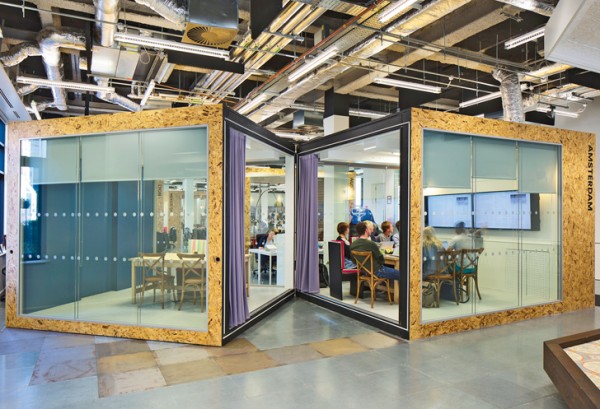
Back in April, Airbnb opened their new state of the art European Headquarters at the Watermarque building in Ringsend, and announced plans to add 100 people to their workforce.
They’re coming into town, not just with a younger workforce, or a depressingly fashionable wardrobe, but with swanky new offices that have become the thing to have if you’re a tech company.
Gone is the boring cubicle culture, famously portrayed in the classic flick Office Space, and in is the ultra modern space, where bean bags are everything and if you don’t have a MacBook, you must be crazy.
Airbnb, a technology company that uses its website to connect people to available spare rooms or apartments in cities all across the globe, has come to town with a modern layout that takes some of its inspiration from Dublin itself and throws in some of its own quirky influences just for fun.
“The design of Airbnb’s new home in Dublin lives at the intersection of productivity and fun,” says a spokesperson for the company, “with shared spaces for spontaneous collaboration and meeting rooms modelled after some our most inspiring listings from around the world.”
When you enter the offices, the first thing that hits you is the colour: lots of greys, whites and light greys with subtle hints of reds, greens and yellows. In allocated areas, such as the seating area on the ground floor, staff members can sit and have a meeting surrounded by coloured pillows. Meeting rooms, which look slightly like large cardboard boxes, litter the main intersections of the office and are inspired by Airbnb’s listings around the world.
There’s even a meeting room modelled after an Amsterdam apartment (it can be split into two different work spaces).
There are also a lot of references to the fact that they are based in Dublin, and what better way to say you’re in Dublin than to have a reception area that is modelled on an Irish bar.
“We wanted to capture the incredible spirit of Dublin by working with local architects and incorporating elements like a pub reception area and Irish telephone boxes,” says the spokesperson.
Workspaces take up most of the space, situated at the centre of the room; these areas act as the staple of the project, housing what will soon be 200 staff. Heneghan Peng, an Irish architecture firm, worked in close proximity with Airbnb to incorporate the overall design, which is sleek, clean and open.
“The long-standing assumption of permanent, individual ownership of workstations by office workers is being replaced by appropriation by increasingly mobile office workers,” writes American architect John Worthington in his 2013 book Reinventing the Workplace. “Each of these multiple settings has specific environmental qualities appropriate to different facets of the office work but all of them are bound together by an invisible network of communications.”
Airbnb is not the only technology company to have smartly designed offices. Google and Facebook (who will be moving closer to Grand Canal Basin in the coming months) also have their own creative spaces. New technology companies tend to invest in creative office environments in order to bolster a happier workforce, which it’s hoped will increase productivity in the long run.
It’s less about a swanky office than the creation of a different kind of office environment, one that promotes openness and creativity. It’s one thing to have a nice office, but does it actually increase productivity in the long run? Considering Airbnb’s recent investment in the Dublin 4 area, they must be on to something.
Photography by Airbnb.com and Ed Reeve.
By Liam Cahill

